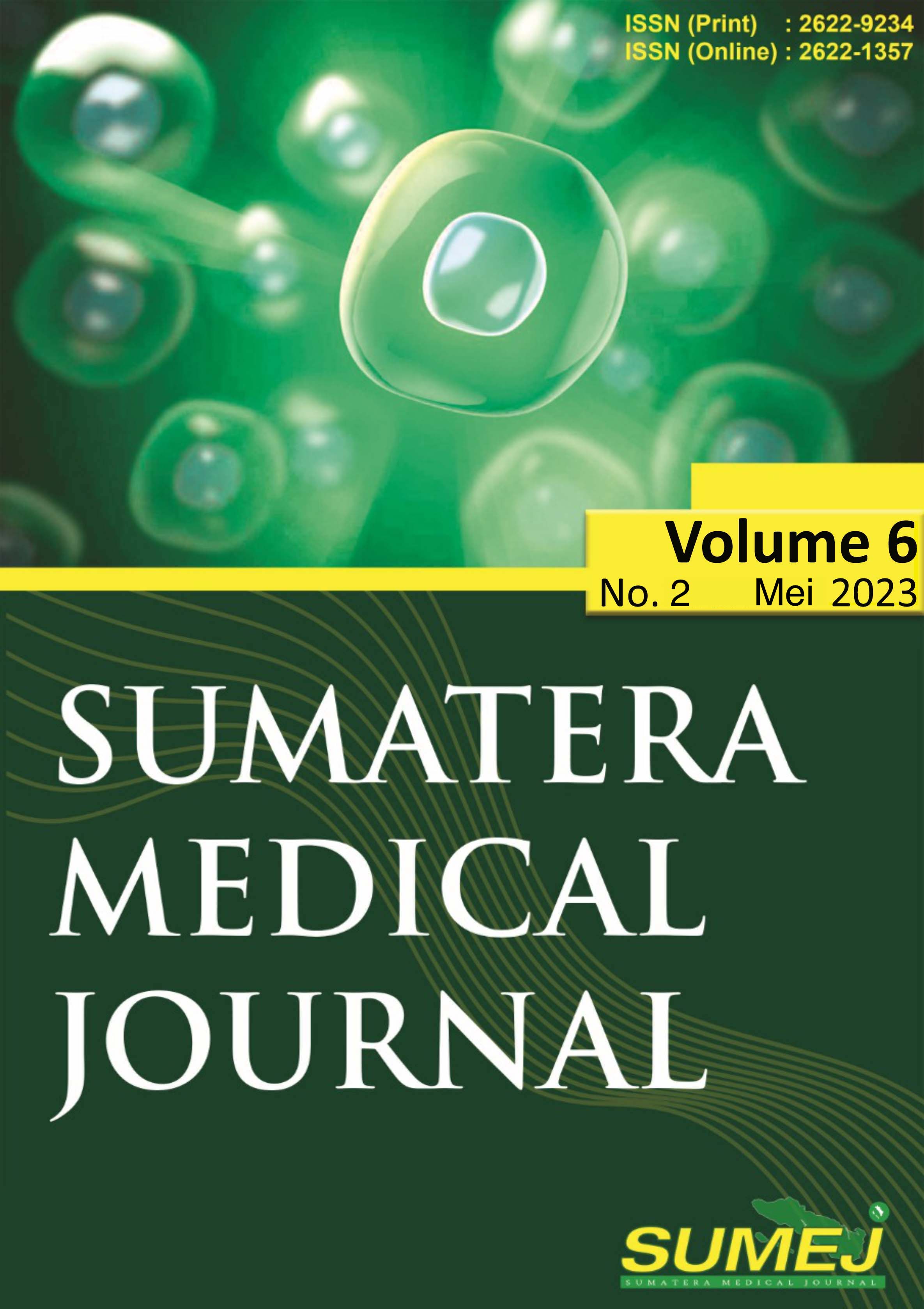Prevalence and Correlated Factors of Urinary Incontinence in Geriatrics
DOI:
https://doi.org/10.32734/sumej.v6i2.11030Keywords:
geriatrics, prevalence, risk factors, urinary incontinenceAbstract
Background: Urinary incontinence is involuntary or uncontrollable urine passing. This is very disruptive, it causes a lot of problems and is often seen as an embarrassing thing. The prevalence of urinary incontinence was found to increase with age. Objective: This research aimed to determine the prevalence and factors associated with the incidence of urinary incontinence in geriatric patients at the Haji Adam Malik General Central Hospital and the University of North Sumatera Hospital. Methods: This type of research is an analytic observational study with a cross-sectional design. The research sample is determined by consecutive sampling technique using a questionnaire as primary data. Results: Out of 100 respondents, 22 geriatric patients experienced urinary incontinence, with the majority experiencing moderate severity and stress urinary incontinence. Based on bivariate analysis using chi-square found gender (p=0.617), age (p=0.617), overweight (p=<0.01), diabetes mellitus (p=<0.01), hypertension (p=0.01), history of chronic cough (p=<0.01), history of pelvic surgery (p=<0.01), and history of vaginal delivery (0=0.055). Conclusion: In this study, the risk factors associated with urinary incontinence are overweight, diabetes mellitus, hypertension, and a history of chronic cough while risk factors that are not found to be associated in this study are age, sex, and history of vaginal delivery.
Downloads
References
D’Ancona C, Haylen B, Oelke M, Abranches-Monteiro L, Arnold E, et al. The International Continence Society (ICS) report on the terminology for adult male lower urinary tract and pelvic floor symptoms and dysfunction. Neurourol Urodyn. 2019;38:433–77.
Martono HH, Darmojo RB. Buku ajar geriatrik (Ilmu kesehatan usia lanjut). Jakarta: Balai Penerbit Fakultas Kedokteran Universitas Indonesia; 2006.
Seipei T, Schauss AG. Lower urinary tract symptoms, overactive bladder syndrome, and urinary incontinence (LUTS, OAB, and UI). In: Pizzorno JE, Murray MT, editors. Textbook of natural medicine. 5th ed. St. Louis: Elsevier; 2020. p. 1533–44.
Perkumpulan Kontinensia Indonesia (PERKINA). Panduan tata laksana inkontinensia urin pada dewasa. 2nd ed. Jakarta: Ikatan Ahli Urologi Indonesia; 2018.
Chapple CR, Milsom I. Urinary incontinence and pelvic prolapse: Epidemiology and pathophysiology. In: Wein AJ, Kavoussi LR, Novick AC, Partin AW, Peters CA, editors. Campbell-Walsh urology. 10th ed. Philadelphia: Elsevier-Saunders; 2012.
Goepel M, Kirschner-Hermanns R, Welz-Barth RA, Steinwachs KC, et al. Urinary incontinence in the elderly: Part 3 of a series of articles on incontinence. Dtsch Arztebl Int. 2010.
World Health Organization. Ageing and health. 2021. Available from: https://www.who.int/news-room/fact-sheets/detail/ageing-and-health
Badan Pusat Statistik. Statistik penduduk lanjut usia. Jakarta: Badan Pusat Statistik; 2019.
Cesari M, Calvani R, Marzetti E. Frailty in older persons. Clin Geriatr Med. 2017;33:293–303.
Amelia R. Prevalensi dan faktor risiko inkontinensia urin pada lansia di Panti Sosial Tuna Werdha (PSTW) Sabai Nan Aluih Sicincin Pariaman. Health Med J. 2020;2:39–44.
Sumardi R, Mochtar CA, Junizaf, Budi I, et al. Prevalence of urinary incontinence, risk factors and its impact: Multivariate analysis from Indonesian nationwide survey. Acta Med Indones. 2014;46:175–82.
Irwin DE, Kopp ZS, Agatep B, Milsom I, et al. Worldwide prevalence estimate of lower urinary tract symptoms, overactive bladder, urinary incontinence and bladder outlet obstruction. BJU Int. 2011.
Yates A. Urinary continence care for older people in the acute setting. Br J Nurs. 2017;26(9):28–30.
Schreiber Pedersen L, Lose G, Høybye MT, Elsner S, Waldmann A, Rudnicki M. Prevalence of urinary incontinence among women and analysis of potential risk factors in Germany and Denmark. Acta Obstet Gynecol Scand. 2017;96(8):939–48.
Griebling TL. Urinary incontinence in the elderly. Clin Geriatr Med. 2009.
Wein AJ, Kavoussi LR, Novick AC. Campbell-Walsh urology. Vol. 148. Philadelphia: Elsevier; [year not defined].
Ninomiya S, Naito K, Nakanishi K, Okayama H. Prevalence and risk factors of urinary incontinence and overactive bladder in Japanese women. Low Urin Tract Symptoms. 2018;10(3):308–14.
Downloads
Published
How to Cite
Issue
Section
License
Copyright (c) 2023 Sumatera Medical Journal

This work is licensed under a Creative Commons Attribution-NonCommercial-NoDerivatives 4.0 International License.
The Authors submitting a manuscript do so on the understanding that if accepted for publication, copyright of the article shall be assigned to Sumatera Medical Journal (SUMEJ) and Faculty of Medicine as well as TALENTA Publisher Universitas Sumatera Utara as publisher of the journal.
Copyright encompasses exclusive rights to reproduce and deliver the article in all form and media. The reproduction of any part of this journal, its storage in databases and its transmission by any form or media, will be allowed only with a written permission from Sumatera Medical Journal (SUMEJ).
The Copyright Transfer Form can be downloaded here.
The copyright form should be signed originally and sent to the Editorial Office in the form of original mail or scanned document.











